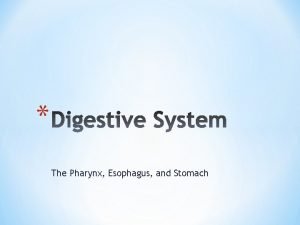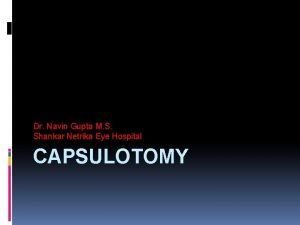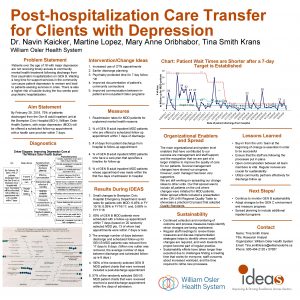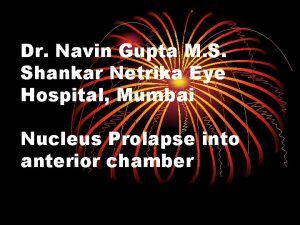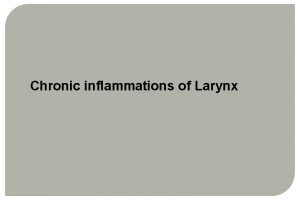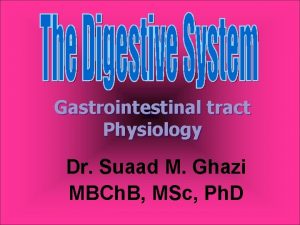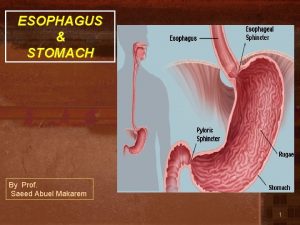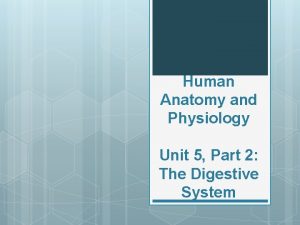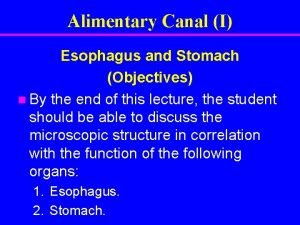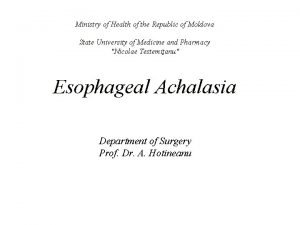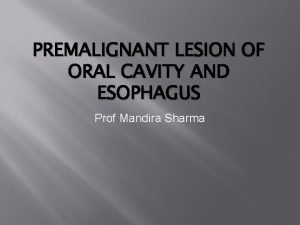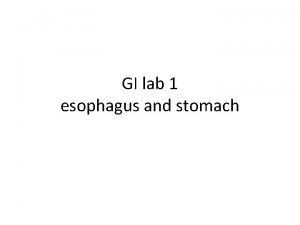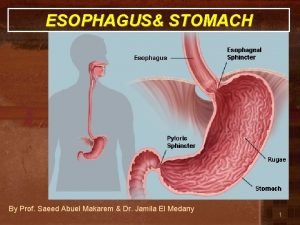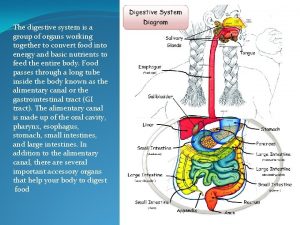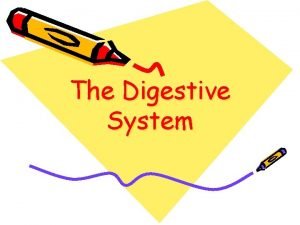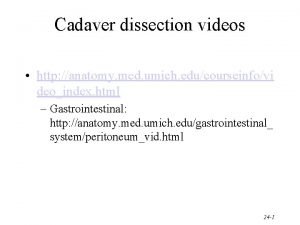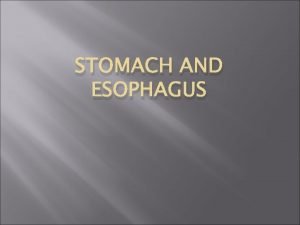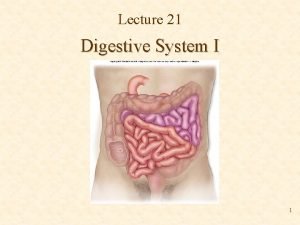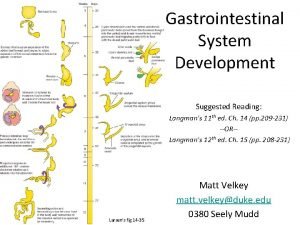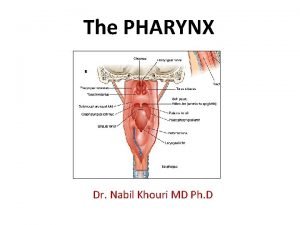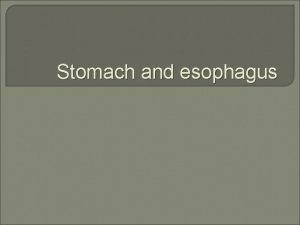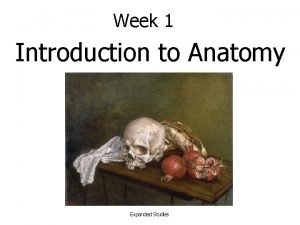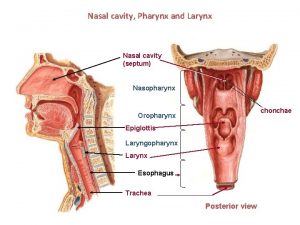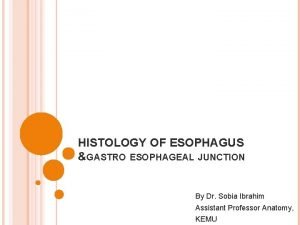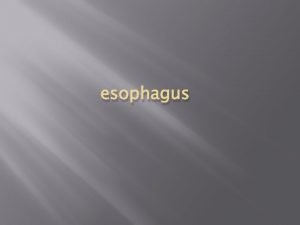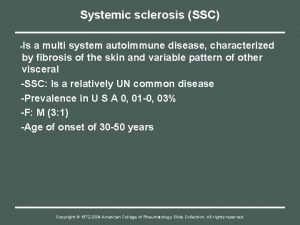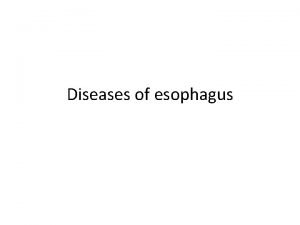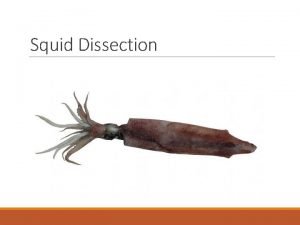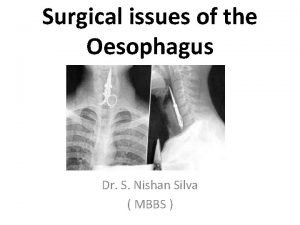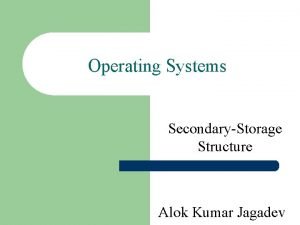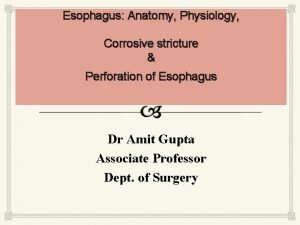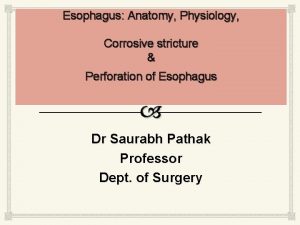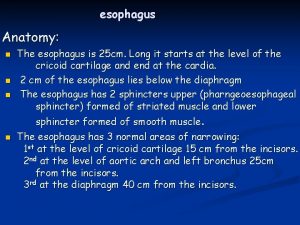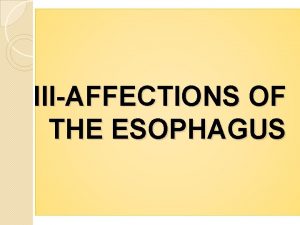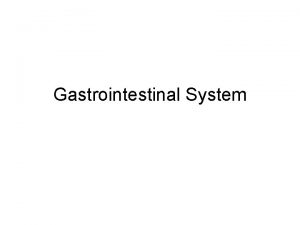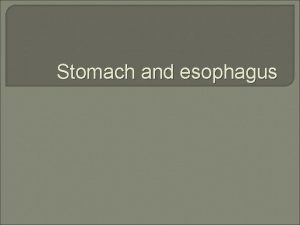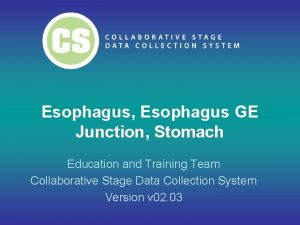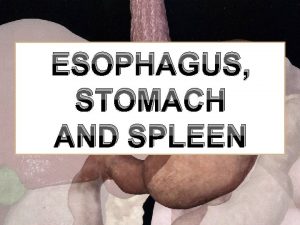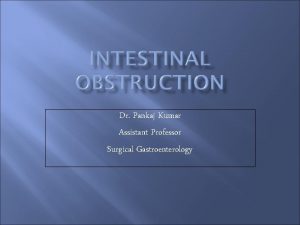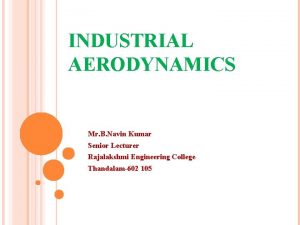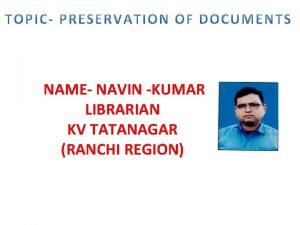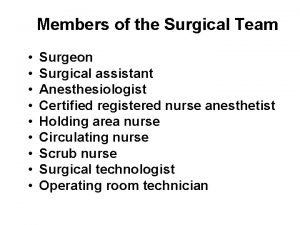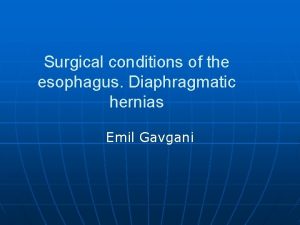Esophagus surgical anatomy Dr Navin Kumar Assistant Professor

















































- Slides: 49

Esophagus- surgical anatomy Dr. Navin Kumar Assistant Professor

Anatomy


Relations… • Right side- mediastinal pleura & terminal part of azygous vein • Left side- left subclavian artery, aortic arch, thoracic duct, mediastinal pleura • When esophagus pierces the diaphragm, it is accompanied by two vagi, branches of left gastric artery & lymphatic vessels. • In abdomen – left lobe of liver anteriorly & left crus of diaphragm posteriorly.

Constrictions I – Pharyngo-esophageal junction -15 cm from incisor teeth. II- Aortic arch and left bronchus crosses esophagus anteriorly- 25 cm from incisor teeth.

Clinical importance of constrictions of esophagus • Common site for lodgment of foreign body • Common site for stricture formation after corrosive ingestion • Common site for carcinoma of esophagus • Difficult sites for passage of esophagoscope.

Length of the Esophagus • The distance between the cricoid cartilage and the gastric orifice. • In adults, it ranges from 22 to 28 cm, 3 to 6 cm of which is located in the abdomen. • length of the esophagus is related to the subject's height rather than sex. • Cervical – 5 cm • Thoracic -18 -20 cm • Abdomen – 2 -4 cm

Blood supply • Upper 1/3 – inferior thyroid artery • Middle 1/3 – direct branches from aorta. • Lower 1/3 – left gastric artery

Venous drainage • Upper 1/3 – inferior thyroid vein • Middle 1/3 – Azygous and hemiazygous vein. • Lower 1/3 - left gastric vein

Nerve supply (Extrinsic) • Esophageal plexus – formed by vagus nerves by joining with sympathetic nerves below the root of lungs. • LARP- left vagus anteriorly • Right vagus posteriorly

Nerve suply • Extrinsic –vagus • Intrinsic – • Auerbach /myentric plexus - between longitudinal and circular muscle • Peristalsis • Meissner’s plexusat submucosal level – for secretion • Meissner’s submucosal plexus is sparse in the esophagus. • The parasympathetic nerve supply is mediated by branches of the vagus nerve • that has synaptic connections to the myenteric (Auerbach’s) plexus.

Lymphatic drainage • Upper 1/3 • deep cervical nodes. • Middle 1/3 • superior & posterior mediastinal nodes • Lower 1/3 • celiac nodes

Diameter of the Esophagus • The esophagus is the narrowest tube in the intestinal tract. • At rest, the esophagus is collapsed; it forms a soft muscular tube. • Flat in its upper and middle parts, with a diameter of 1. 6 cm. • The lower esophagus is rounded, and its diameter is 2. 4 cm.

Musculature • The musculature of the upper esophagus & UES is striated. • This is followed by a transitional zone of both striated and smooth muscle. • proportion of the smooth muscle. progressively increasing. • In the lower half of the esophagus, there is only smooth muscle. • It is lined throughout with squamous epithelium.

Layers 1. Mucosa – • epithelium • Basement membrane • Lamina Propria 2. Submucosa- strongest layer 3. Muscular propria • Inner circular • Outer longitudinal 4. Adventitia –visceral peritoneum

Periesophageal Tissue, Compartments, and Fascial Planes • Unlike the general structure of the digestive tract, the esophageal tube has neither mesentery nor serosal coating. • Its position within the mediastinum and a complete envelope of loose connective tissue allow the esophagus extensive transverse and longitudinal mobility. • The esophagus may be subjected to easy blunt stripping from the mediastinum.

Clinical relevance • The connective tissues in which the esophagus and trachea are embedded are bounded by fascial planes, • the pretracheal fascia anteriorly and • the prevertebral fascia posteriorly. • In the upper part of the chest, both fascia unite to form the carotid sheath.

Tunica Adventitia • This thin coat of loose connective tissue envelops the esophagus. • connects it to adjacent structures, • contains small vessels, lymphatic channels, and nerves.

Tunica Muscularis • The tunica muscularis coats the lumen of the esophagus in two layers : • the external muscle layer parallels the longitudinal axis of the tube, • the muscle fibers of the inner layer are arranged in the horizontal axis. • For this reason, these muscle layers are classically called longitudinal and circular, respectively.

Tela Submucosa • The submucosa is the connective tissue layer that lies between the muscular coat and the mucosa. • It contains a meshwork of small blood and lymph vessels, nerves, and mucous glands. • The duct of deep esophageal glands pierce the muscularis mucosae.

Tunica Mucosa • The mucous layer is composed of three components: • the muscularis mucosae, • the tunica / lamina propria, and • the inner lining of nonkeratinizing stratified squamous epithelium.

Physiology of the Esophagus and Its Sphincters

Physiology • The musculature of the esophagus = predominantly striated at the level of the UES and proximal 1 to 2 cm of the esophagus. • mixed striated = smooth muscle transition zone spanning 4 to 5 cm • Entirely smooth muscle structure = in the distal 50% to 60% of the esophagus, including the LES

SWALLOWING PROCESS • Normal human subjects swallow on average 500 times a day. • The act of swallowing can be divided into three stages: 1. the oral (voluntary) stage, 2. the pharyngeal (involuntary) stage, and 3. the esophageal stage. • These stages are a continuous process closely coordinated through the medullary swallowing centers.

Esophageal Stage • The esophageal stage of swallowing starts once the food is transferred from the oral cavity through the UES into the esophagus. • This active process is achieved by contractions of the circular and longitudinal muscles of the tubular esophagus and coordinated relaxation of the LES. • Esophageal peristalsis is controlled by afferent and efferent connections of the medullary swallowing center via the vagus nerve (cranial nerve X).

• The vagus nerve carries both stimulating (cholinergic) and inhibitory (noncholinergic, nonadrenergic) information to the esophageal musculature. • In addition to the central nervous system control, the myenteric (Auerbach) plexus • plays a major role in coordinating peristalsis in the smooth muscle portion of the distal esophagus.

Esophageal peristalsis • Esophageal peristalsis is the result of sequential contraction of the circular esophageal muscle. • Three distinct patters of esophageal contractions have been described: 1. Primary peristalsis 2. Secondary peristalsis 3. Tertiary contractions.

Primary peristalsis • Primary peristaltic contractions are the usual form of the contraction waves of circular muscles that progress down the esophagus; • they are initiated by the central mechanisms that follow the voluntary act of swallowing. • During primary peristalsis, the LES is relaxed, starting at the initiation of swallowing and lasting until the peristalsis reaches the LES.

Secondary peristalsis • Secondary peristaltic contractions are the contraction waves of the circular esophageal muscle occurring in response to esophageal distention. • They are not a result of central mechanisms. • The role of secondary peristaltic contractions is to clear the esophageal lumen of ingested material not cleared by primary peristalsis or material that is refluxed from the stomach. • Tertiary contractions are primarily identified during barium x-ray studies and represent non-peristaltic contraction waves that leave segmental indentations on the barium column.

LES • Normal LES resting pressure ranges from 10 to 45 mm Hg above the gastric baseline level. • The function of the LES is to • prevent gastroesophageal reflux and • to relax with swallowing to allow movement of ingested food into the stomach.

Perforation of the oesophagus • Causes 1. 2. 3. 4. usually iatrogenic (at therapeutic endoscopy) or due to ‘barotrauma’ (spontaneous perforation). Pathological perforation- rare Penetrating injury

Barotrauma (spontaneous perforation, Boerhaave syndrome) • This occurs classically when a person vomits against a closed glottis. • The pressure in the oesophagus increases rapidly, and the oesophagus bursts at its weakest point in the lower third, sending a stream of material into the mediastinum and often the pleural cavity as well. • The condition was first reported by Boerhaave , who reported the case of a grand admiral of the Dutch fleet who was a glutton and practised auto emesis.

Boerhaave syndrome… • Most serious type of perforation • because of the large volume of material that is released under pressure. • mediastinitis • Barotrauma has also been described in relation to other pressure events when the patient strains against a closed glottis (e. g. defaecation, labour, weight-lifting).

Diagnosis of spontaneous perforation • history • severe pain in the chest or upper abdomen following a meal or a bout of drinking. • shortness of breath • O/E- • rigidity on examination of the upper abdomen, even in the absence of any peritoneal contamination. • D/D • myocardial infarction, • perforated peptic ulcer or • pancreatitis if the pain is confined to the upper abdomen.

Boerhaave syndrome… 1. Chest x-ray - confirmatory • air in the mediastinum, pleura or peritoneum. 2. A contrast swallow or 3. CT scan

Pathological perforation • Free perforation of ulcers or tumors of the oesophagus into the pleural space is rare. • Erosion into an adjacent structure with fistula formation is more common. • Aerodigestive fistula is most common and usually encountered in primary malignant disease of the oesophagus or bronchus. • Covering the communication with a self-expanding metal stent is the usual solution.

Penetrating injury • Perforation by knives and bullets is uncommon

Instrumental perforation • Instrumentation is by far the most common cause of perforation. • Incidence - 1: 4000 examinations /UGIE

Diagnosis of instrumental perforation • History and physical signs may be useful pointers to the site of perforation. 1. Cervical perforation: • • pain localised to the neck, hoarseness, painful neck movements and subcutaneous emphysema.

2. Intrathoracic and intra-abdominal perforations, (more common), • Immediate symptoms and signs • chest pain, • haemodynamic instability, • oxygen desaturation. • evidence of subcutaneous hydropneumothorax. emphysema, pneumothorax or

Treatment of oesophageal perforations • Perforation of the oesophagus usually leads to mediastinitis. • The loose areolar tissues of the posterior mediastinum allow a rapid spread of gastrointestinal contents. • Aim of treatment • limit mediastinal contamination and • prevent or deal with infection.

Decision between operative and nonoperative management rests on four factors 1. the site of the perforation (cervical versus thoraco-abdominal oesophagus); 2. the event causing the perforation (spontaneous versus instrumental); 3. underlying pathology (benign or malignant); 4. the status of the oesophagus before the perforation (fasted and empty versus obstructed with a stagnant residue).

Non-operative treatment of Instrumental perforations • Cervical oesophagus - are usually small perforation and can nearly always be managed conservatively. • The development of a local abscess is an indication for cervical drainage preventing the extension of sepsis into the mediastinum.

Indication for non-operative management (thoraco-abdominal perforation) • when the perforation is detected early and prior to oral alimentation. • absence of • crepitus, • diffuse mediastinal gas, • Hydro-pneumothorax or pneumo-peritoneum; • mediastinal containment of the perforation with no evidence of widespread extravasation of contrast material; • no evidence of ongoing luminal obstruction or a retained foreign body. • patients who have remained clinically stable despite diagnostic delay.

Principles of non-interventional management • nasogastric suction and • broad-spectrum intravenous antibiotics

Indication of Surgical management • unstable with sepsis or shock; • have evidence of a heavily contaminated mediastinum, pleural space or peritoneum; • have widespread intra-pleural or intra-peritoneal extravasation of contrast material.

Surgery • direct repair, • the deliberate creation of an external fistula or, • rarely, oesophageal resection with a view to delayed reconstruction. • Direct repair • if the perforation is recognised early (within the first 4– 6 hours) and the extent of mediastinal and pleural contamination is small. • After 12 hours, the tissues become swollen and friable , primary repair not possible.

MALLORY–WEISS SYNDROME • Forceful vomiting may produce a mucosal tear at the cardia rather than a full perforation. • In Boerhaave’s syndrome, vomiting occurs against a closed glottis, and pressure builds up in the oesophagus. • In Mallory– Weiss syndrome, vigorous vomiting produces a vertical split in the gastric mucosa, immediately below the squamo-columnar junction at the cardia in 90 per cent of cases. • In only 10 per cent is the tear in the oesophagus.

MALLORY–WEISS SYNDROME… • Clinical feature • Haematemesis • Surgery is rarely required.
 Akshay kumar assistant
Akshay kumar assistant Esophageal plexus
Esophageal plexus Esophagus narrowing anatomy
Esophagus narrowing anatomy What side is stomach located in the body
What side is stomach located in the body Navin gupta md
Navin gupta md Furniture upholstry
Furniture upholstry Navin kaicker
Navin kaicker Navin gupta
Navin gupta Navin gupta md
Navin gupta md Fok ping kwan
Fok ping kwan Promotion from associate professor to professor
Promotion from associate professor to professor Mouse nibbled vocal cord
Mouse nibbled vocal cord Gastric glands
Gastric glands Esophagus frog function
Esophagus frog function Stomach location
Stomach location Layers of esophagus
Layers of esophagus Rugae in stomach
Rugae in stomach Dr haris manzoor qadri
Dr haris manzoor qadri Epidermoid carcinoma
Epidermoid carcinoma Where is peritoneal cavity located
Where is peritoneal cavity located Gastric
Gastric Abdomen regions
Abdomen regions Esophagus stomach small intestine large intestine
Esophagus stomach small intestine large intestine Digestive system for labelling
Digestive system for labelling Pancreas anatomy cadaver
Pancreas anatomy cadaver Stomach blood supply
Stomach blood supply Pharynx and oral cavity
Pharynx and oral cavity Vitellointestinal duct
Vitellointestinal duct Barrett's esophagus
Barrett's esophagus Cervical esophagus
Cervical esophagus Diffuse esophageal spasm barium swallow
Diffuse esophageal spasm barium swallow Lymphatic supply of stomach
Lymphatic supply of stomach Identify the organ
Identify the organ Bronchiole
Bronchiole Site:slidetodoc.com
Site:slidetodoc.com Mallory wiess tear
Mallory wiess tear Esophagus
Esophagus Mauskopf scleroderma
Mauskopf scleroderma Nutcracker esophagus
Nutcracker esophagus Squid anatomy labeled
Squid anatomy labeled Hernia slokdarm
Hernia slokdarm Rohtash kumar vs state of haryana
Rohtash kumar vs state of haryana Rajesh kumar bhagat
Rajesh kumar bhagat Saha chapter 1
Saha chapter 1 Kumar samrudhi society
Kumar samrudhi society Kumar venkitanarayanan
Kumar venkitanarayanan Kumar
Kumar Col 106 amit kumar
Col 106 amit kumar Ravi kumar kopparapu
Ravi kumar kopparapu Alok kumar jagadev
Alok kumar jagadev



